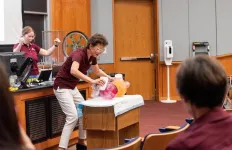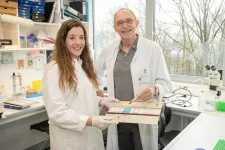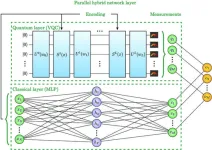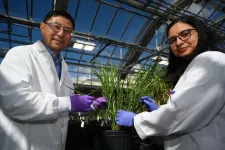(Press-News.org) A new sounding rocket mission is headed to space to understand how explosive stellar deaths lay the groundwork for new star systems. The Integral Field Ultraviolet Spectroscopic Experiment, or INFUSE, sounding rocket mission, will launch from the White Sands Missile Range in New Mexico on Oct. 29, 2023, at 9:35 p.m. MDT.
For a few months each year, the constellation Cygnus (Latin for “swan”) swoops through the northern hemisphere’s night sky. Just above its wing is a favorite target for backyard astronomers and professional scientists alike: the Cygnus Loop, also known as the Veil Nebula.
The Cygnus Loop is the remnant of a star that was once 20 times the size of our Sun. Some 20,000 years ago, that star collapsed under its own gravity and erupted into a supernova. Even from 2,600 light-years away, astronomers estimate the flash of light would have been bright enough to see from Earth during the day.
Supernovae are part of a great life cycle. They spray heavy metals forged in a star’s core into the clouds of surrounding dust and gas. They are the source of all chemical elements in our universe heavier than iron, including those that make up our own bodies. From the churned-up clouds and star stuff left in their wake, gases and dust from supernovae gradually clump together to form planets, stars, and new star systems.
“Supernovae like the one that created the Cygnus Loop have a huge impact on how galaxies form,” said Brian Fleming, a research professor at the University of Colorado Boulder and principal investigator for the INFUSE mission.
The Cygnus Loop provides a rare look at a supernova blast still in progress. Already over 120 light-years across, the massive cloud is still expanding today at approximately 930,000 miles per hour (about 1.5 million kilometers per hour).
What our telescopes capture from the Cygnus Loop is not the supernova blast itself. Instead, we see the dust and gas superheated by the shock front, which glows as it cools back down.
“INFUSE will observe how the supernova dumps energy into the Milky Way by catching light given off just as the blast wave crashes into pockets of cold gas floating around the galaxy,” Fleming said.
To see that shock front at its sizzling edge, Fleming and his team have developed a telescope that measures far-ultraviolet light – a kind of light too energetic for our eyes to see. This light reveals gas at temperatures between 90,000 and 540,000 degrees Fahrenheit (about 50,000 to 300,000 degrees Celsius) that is still sizzling after impact.
INFUSE is an integral field spectrograph, the first instrument of its kind to fly to space. The instrument combines the strengths of two ways of studying light: imaging and spectroscopy. Your typical telescopes have cameras that excel at creating images – showing where light is coming from, faithfully revealing its spatial arrangement. But telescopes don’t separate light into different wavelengths or “colors” – instead, all of the different wavelengths overlap one another in the resulting image.
Spectroscopy, on the other hand, takes a single beam of light and separates it into its component wavelengths or spectrum, much as a prism separates light into a rainbow. This procedure reveals all kinds of information about what the light source is made of, its temperature, and how it is moving. But spectroscopy can only look at a single sliver of light at a time. It’s like looking at the night sky through a narrow keyhole.
The INFUSE instrument captures an image and then “slices” it up, lining up the slices into one giant “keyhole.” The spectrometer can then spread each of the slices into its spectrum. This data can be reassembled into a 3-dimensional image that scientists call a “data cube” – like a stack of images where each layer reveals a specific wavelength of light.
Using the data from INFUSE, Fleming and his team will not only identify specific elements and their temperatures, but they’ll also see where those different elements lie along the shock front.
“It’s a very exciting project to be a part of,” said lead graduate student Emily Witt, also at CU Boulder, who led most of the assembly and testing of INFUSE and will lead the data analysis. “With these first-of-their-kind measurements, we will better understand how these elements from the supernova mix with the environment around them. It’s a big step toward understanding how material from supernovas becomes part of planets like Earth and even people like us.”
To get to space, the INFUSE payload will fly aboard a sounding rocket. These nimble, crewless rockets launch into space for a few minutes of data collection before falling back to the ground. The INFUSE payload will fly aboard a two-stage Black Brant 9 sounding rocket, aiming for a peak altitude of about 150 miles (240 kilometers), where it will make its observations, before parachuting back to the ground to be recovered. The team hopes to upgrade the instrument and launch again. In fact, parts of the INFUSE rocket are themselves repurposed from the DEUCE mission, which launched from Australia in 2022.
NASA's Sounding Rocket Program is conducted at the agency's Wallops Flight Facility at Wallops Island, Virginia, which is managed by NASA’s Goddard Space Flight Center in Greenbelt, Maryland. NASA's Heliophysics Division manages the sounding rocket program for the agency. The development of the INFUSE payload was supported by NASA’s Astrophysics Division.
END
NASA rocket to see sizzling edge of star-forming supernova
2023-10-27
ELSE PRESS RELEASES FROM THIS DATE:
IU scientists part of NIH-funded national consortium focused on improving Alzheimer’s disease diagnoses
2023-10-27
INDIANAPOLIS—Researchers at Indiana University School of Medicine will play key roles in a national consortium led by Wake Forest University School of Medicine to study the use, interpretation and implementation of biomarkers to diagnose Alzheimer’s disease.
The multi-institution effort is funded by a five-year, $9 million grant from the National Institute on Aging, part of the National Institutes of Health, that will establish the Alzheimer’s Diagnosis in Older Adults with Chronic Conditions (ADACC) Network.
IU School of Medicine’s Nicole Fowler, ...
Tri-City to partner with UC San Diego Health in delivering world-class medical care
2023-10-27
After open public discussion and a unanimous board vote, Tri-City Healthcare District (“Tri-City” or “District”) announced yesterday that UC San Diego Health has been selected as the District’s future health care partner. A Joint Powers Agreement will now be co-developed that allows UC San Diego Health to provide administrative, clinical and operational management for all health care services with direct input and guidance from a diverse community board. Under the future agreement, UC San Diego ...
Physicist Tatiana Erukhimova earns national award for science outreach
2023-10-27
Texas A&M University physicist Dr. Tatiana Erukhimova has been selected as the 2023 recipient of the American Physical Society Dwight Nicholson Medal for Outreach. Established in 1994 by the Division of Plasma Physics and the Forum on Physics and Society, the Nicholson Medal is awarded annually in recognition of the humanitarian aspect of physics and physicists created through public lectures and public media, teaching, research or science-related activities. The medal is sponsored by the friends of the late plasma physicist and award namesake Dr. Dwight R. Nicholson (1947-1991), former chairman ...
Burt’s Bees® presents clinical evidence demonstrating ability of nature-based products to support barrier function and microbiome health in sensitive skin and lips
2023-10-27
DURHAM, N.C., Oct. 27, 2023 – Burt’s Bees, the #1 dermatologist recommended natural skin care brand* and a pioneer in skin care solutions, announced its latest research findings on the benefits of nature-based regimens to cleanse, nourish, and protect skin health. The studies will be presented at the hybrid Integrative Dermatology Symposium (IDS) from Oct. 27-29, 2023.
The latest research findings from Burt’s Bees highlight:
The ability of a topical treatment with a unique blend of botanicals to improve appearance of age spots in diverse skin.
The impact of a lip care product with naturally derived plant oils, butters, beeswax, ...
Possible cause of male infertility
2023-10-27
Bonn, 27. October - Mature spermatozoa are characterized by an head, midpiece and a long tail for locomotion. Now, researchers from the University Hospital Bonn (UKB) and the Transdisciplinary Research Unit "Life & Health" at the University of Bonn have found that a loss of the structural protein ACTL7B blocks spermatogenesis in male mice. The cells can no longer develop their characteristic shape and remain in a rather round form. The animals are infertile. The results of the study have now been published in the scientific journal "Development".
Male ...
Online games use dark designs to collect player data
2023-10-27
Gaming is a $193 billion industry – nearly double the size of the film and music industries combined – and there are around three billion gamers worldwide. While online gaming can improve wellbeing and foster social relations, privacy and awareness issues could potentially offset these benefits and cause real harm to gamers.
The new study, by scientists at Aalto University’s Department of Computer Science, reveals potentially questionable data collection practices in online games, along with misconceptions and concerns about privacy among players. The study also offers ...
New parallel hybrid network achieves better performance through quantum-classical collaboration
2023-10-27
Building efficient quantum neural networks is a promising direction for research at the intersection of quantum computing and machine learning. A team at Terra Quantum AG designed a parallel hybrid quantum neural network and demonstrated that their model is "a powerful tool for quantum machine learning." This research was published Oct. 9 in Intelligent Computing, a Science Partner Journal.
Hybrid quantum neural networks typically consist of both a quantum layer — a variational quantum circuit — and a classical layer — a deep learning neural network called a multi-layered perceptron. This special architecture enables them to learn complicated patterns and relationships ...
Researchers at MedStar Health and Georgetown Law find success in integrating lawyers into care teams to support pregnant and postpartum patients
2023-10-27
WASHINGTON – Medical-legal partnerships (MLPs), which include a lawyer as part of a patient’s care team, can help health systems address health-harming legal needs and better support pregnant and postpartum patients, according to a new research commentary published today in Obstetrics & Gynecology. The article offers insights and expert advice from Georgetown University Health Justice Alliance’s Perinatal Legal Assistance and Wellbeing (LAW) Project at MedStar Washington Hospital Center, one of the first medical-legal partnerships ...
Hydrogel developed by Brazilian researchers improves skin wound healing in diabetics
2023-10-27
Researchers in São Paulo state, Brazil, have developed a low-cost anti-inflammatory hydrogel that in future could help treat chronic skin lesions such as those often seen in people with diabetes. They report the results of animal tests in an article published in the journal Biomedicine & Pharmacotherapy.
According to the International Diabetes Federation, Brazil ranks sixth among countries with the most cases of diabetes, which has reached epidemic proportions and become the fifth most frequent cause of death in the world. Some 17.7 million Brazilians suffer daily from the metabolic alterations caused ...
Unlocking sugar to generate biofuels and bioproducts
2023-10-27
UPTON, NY—Plant biologists at the U.S. Department of Energy’s (DOE) Brookhaven National Laboratory have engineered enzymes to modify grass plants so their biomass can be more efficiently converted into biofuels and other bioproducts. As described in a paper just published in Plant Biotechnology Journal, these enzymes modify molecules that make up plant cell walls to provide access to fuel-generating sugars normally locked within complex structures.
“The concept of biomass to biofuel seems simple, but it is technically very difficult to release the sugars,” noted Chang-Jun Liu, a senior plant biologist at Brookhaven ...





